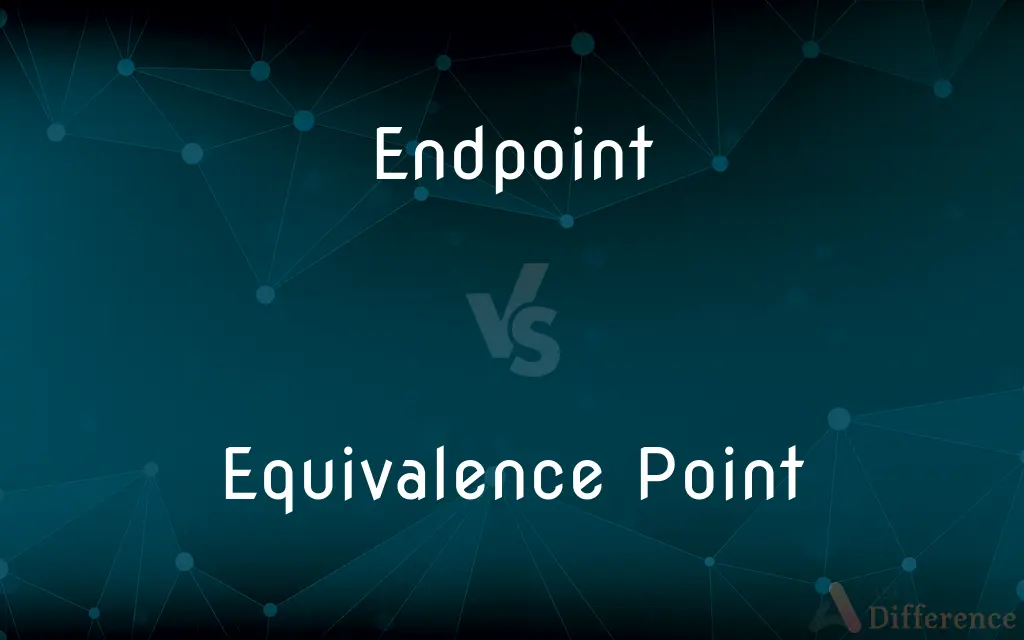Endpoint vs. Equivalence Point — What's the Difference?
By Tayyaba Rehman & Urooj Arif — Published on February 8, 2024
Endpoint is where a titration's color change occurs; Equivalence Point is when reactants are in stoichiometric balance.

Difference Between Endpoint and Equivalence Point
Table of Contents
ADVERTISEMENT
Key Differences
The Endpoint in a titration process is the stage at which an indicator changes color, signaling the completion of the reaction from a practical standpoint. This color change may not precisely coincide with the stoichiometric point of the reaction. The Equivalence Point, however, is the theoretical point at which the quantities of reactants have reacted in exact stoichiometric proportions, meaning the moles of acid equal the moles of base in a neutralization reaction.
In practical terms, the Endpoint is determined by the use of an indicator that undergoes a visible change at a particular pH range. This change is often close to, but not exactly at, the Equivalence Point. The Equivalence Point is a concept rooted in the stoichiometry of the reaction, independent of any indicator used, and represents the point at which the chemical reaction is perfectly balanced.
The difference between the Endpoint and the Equivalence Point can lead to a titration error if the indicator's color change does not closely align with the Equivalence Point. In an ideal titration, the Endpoint would occur exactly at the Equivalence Point, but various factors, including the choice of indicator and the reaction's speed, can cause a slight discrepancy between these two points.
In some reactions, especially those with a sharp pH change near the Equivalence Point, the Endpoint can closely match the Equivalence Point. However, in cases where the pH change is more gradual, selecting the appropriate indicator becomes crucial to minimize the difference between the Endpoint and the Equivalence Point.
Lastly, understanding the relationship between the Endpoint and the Equivalence Point is essential for accurately interpreting titration results. While the Endpoint is observable and practical, the Equivalence Point is theoretical and represents the completion of the reaction on a molecular level.
ADVERTISEMENT
Comparison Chart
Definition
Point where the indicator changes color in a titration.
Theoretical point where reactants are in stoichiometric balance.
Dependence
Dependent on the indicator used.
Independent of indicators, based on stoichiometry.
Significance
Practical, observable endpoint of a titration.
Theoretical point indicating complete reaction.
Accuracy
May not coincide with the stoichiometric point.
Represents the exact stoichiometric point.
Indicator's Role
Crucial for determining the Endpoint.
Irrelevant for determining the Equivalence Point.
Compare with Definitions
Endpoint
Endpoint is the stage in a titration where the indicator changes color.
The titration reached its Endpoint when the solution turned pink.
Equivalence Point
Equivalence Point is where equal moles of acid and base have reacted in a titration.
At the Equivalence Point, the amount of acid neutralized the base completely.
Endpoint
Endpoint can vary based on the choice of indicator used in the titration.
Choosing phenolphthalein as the indicator set the Endpoint at a slightly basic pH.
Equivalence Point
Equivalence Point is independent of indicators and relies on stoichiometry.
Calculating the Equivalence Point required precise stoichiometric calculations.
Endpoint
Endpoint is an observable phenomenon indicating the end of a titration.
The Endpoint was clearly visible when the solution's color remained stable.
Equivalence Point
Equivalence Point is the theoretical completion point of a reaction in titration.
The Equivalence Point was determined to be at a pH of 7.0 for the neutralization reaction.
Endpoint
Endpoint is used to approximate the Equivalence Point in practical experiments.
We approximated the Equivalence Point by carefully observing the Endpoint.
Equivalence Point
Equivalence Point can be determined graphically through titration curves.
The titration curve intersected at the Equivalence Point, indicating complete reaction.
Endpoint
Either of two points marking the end of a line segment.
Equivalence Point
Equivalence Point represents the stoichiometric balance in a chemical reaction.
The titration curve showed a sharp inflection at the Equivalence Point.
Endpoint
(Chemistry) The point in a titration at which no more titrant should be added. It is determined, for example, by a color change in an indicator or by the appearance of a precipitate.
Endpoint
A tip or point of termination.
Endpoint
Either of the two points at the ends of a line segment.
Endpoint
A defined occurrence during the observation period of an experiment or study.
Endpoint
(chemistry) The stage in a titration at which a change in the colour of an indicator indicates that no more titrant should be added.
Endpoint
The entity at one end of a connection.
Endpoint
(programming) Part of a system that serves as a hook, allowing third-party code to intercept and modify behaviour at that point.
Endpoint
(mathematics) Either of the two nodes of a graph of degree 1.
Endpoint
A point of termination or completion.
Endpoint
A place where something ends or is complete
Endpoint
Endpoint marks the perceived completion of a reaction in a titration experiment.
We determined the titration's Endpoint by the sudden color shift.
Common Curiosities
Can the Endpoint and Equivalence Point differ?
Yes, the Endpoint may not precisely match the Equivalence Point due to the indicator's properties.
Why is the Equivalence Point important?
The Equivalence Point is crucial for understanding the exact stoichiometric balance in a reaction.
What is an Endpoint in titration?
The Endpoint is where the indicator changes color, signifying the titration's practical completion.
What defines the Equivalence Point?
The Equivalence Point is the theoretical moment when reactants are in perfect stoichiometric balance.
How is the Endpoint determined?
The Endpoint is determined by the color change of the indicator used in the titration.
How do indicators affect the Endpoint?
The choice of indicator can influence where the Endpoint occurs due to its pH sensitivity range.
How can one minimize the difference between Endpoint and Equivalence Point?
Selecting an appropriate indicator that changes color at or near the stoichiometric balance can minimize the difference.
Why might the Endpoint not indicate the true completion of a reaction?
The Endpoint might not align with the Equivalence Point due to a gradual pH change or an inappropriate indicator.
What happens if the Endpoint is significantly different from the Equivalence Point?
A significant difference can lead to inaccuracies in determining the concentration of the titrated solution.
What role does a titration curve play in identifying the Equivalence Point?
A titration curve helps identify the Equivalence Point by showing a sharp change in pH at the stoichiometric balance.
Can the Equivalence Point occur at different pH values for different reactions?
Yes, the Equivalence Point's pH value depends on the acid and base's strength involved in the reaction.
How can the Equivalence Point be calculated?
The Equivalence Point can be calculated using stoichiometric relationships between the reactants.
Is the Equivalence Point affected by the indicator?
No, the Equivalence Point is based on stoichiometry and is independent of the indicator.
How does the Endpoint relate to the titration's accuracy?
The closer the Endpoint to the Equivalence Point, the more accurate the titration result.
What is the significance of a buffer at the Equivalence Point?
In some titrations, a buffer formed at the Equivalence Point can stabilize the pH, marking the reaction's completion.
Share Your Discovery

Previous Comparison
Cristiano Ronaldo vs. Lionel Messi
Next Comparison
Stew vs. ShorbaAuthor Spotlight
Written by
Tayyaba RehmanTayyaba Rehman is a distinguished writer, currently serving as a primary contributor to askdifference.com. As a researcher in semantics and etymology, Tayyaba's passion for the complexity of languages and their distinctions has found a perfect home on the platform. Tayyaba delves into the intricacies of language, distinguishing between commonly confused words and phrases, thereby providing clarity for readers worldwide.
Co-written by
Urooj ArifUrooj is a skilled content writer at Ask Difference, known for her exceptional ability to simplify complex topics into engaging and informative content. With a passion for research and a flair for clear, concise writing, she consistently delivers articles that resonate with our diverse audience.
















































